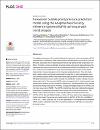Development of oil formation volume factor model using adaptive neuro-fuzzy inference systems ANFIS
| Author | Alakbari F.S. |
| Author | Mohyaldinn M.E. |
| Author | Ayoub M.A. |
| Author | Muhsan A.S. |
| Author | Hussein I.A. |
| Available date | 2022-04-25T10:59:44Z |
| Publication Date | 2021 |
| Publication Name | Society of Petroleum Engineers - SPE/IATMI Asia Pacific Oil and Gas Conference and Exhibition 2021, APOG 2021 |
| Resource | Scopus |
| Identifier | http://dx.doi.org/10.2118/205817-MS |
| Abstract | The oil formation volume factor is one of the main reservoir fluid properties that plays a crucial role in designing successful field development planning and oil and gas production optimization. The oil formation volume factor can be acquired from pressure-volume-temperature (PVT) laboratory experiments; nonetheless, these experiments' results are time-consuming and costly. Therefore, many studies used alternative methods, namely empirical correlations (using regression techniques) and machine learning to determine the formation volume factor. Unfortunately, the previous correlations and machine learning methods have some limitations, such as the lack of accuracy. Furthermore, most earlier models have not studied the relationships between the inputs and outputs to show the proper physical behaviors. Consequently, this study comes to develop a model to predict the oil formation volume factor at the bubble point (Bo) using an adaptive neuro-fuzzy inference system (ANFIS). The ANFIS model was built based on 924 data sets collected from published sources. The ANFIS model and previous 28 models were validated and compared using the trend analysis and statistical error analysis, namely average absolute percent relative error (AAPRE) and correlation coefficient (R). The trend analysis study has shown that the ANFIS model and some previous models follow the correct trend analysis. The ANFIS model is the first rank model and has the lowest AAPRE of 0.71 and the highest (R) of 0.9973. The ANFIS model also has the lowest average percent relative error (APRE), root mean square error (RMSE), and standard deviation (SD) of -0.09, 1.01, 0.0075, respectively. |
| Sponsor | The authors express their appreciation to the Universiti Teknologi PETRONAS for supporting this work under the YUTP-Grant cost center 015LC0-098. They also especially thank COREOR, Petroleum Engineering, Universiti Teknologi PETRONAS, for supporting this work. |
| Language | en |
| Publisher | Society of Petroleum Engineers |
| Subject | Errors Fuzzy inference Fuzzy neural networks Gasoline Machine learning Mean square error Petroleum reservoir engineering Petroleum reservoirs Adaptive neuro-fuzzy inference Adaptive neuro-fuzzy inference system Fluid property Neuro-fuzzy inference systems Oil formation volume factors Pressure-volume-temperatures Reservoir fluid Reservoir fluid property Fuzzy systems |
| Type | Conference |
Files in this item
| Files | Size | Format | View |
|---|---|---|---|
|
There are no files associated with this item. |
|||
This item appears in the following Collection(s)
-
Chemical Engineering [1182 items ]



